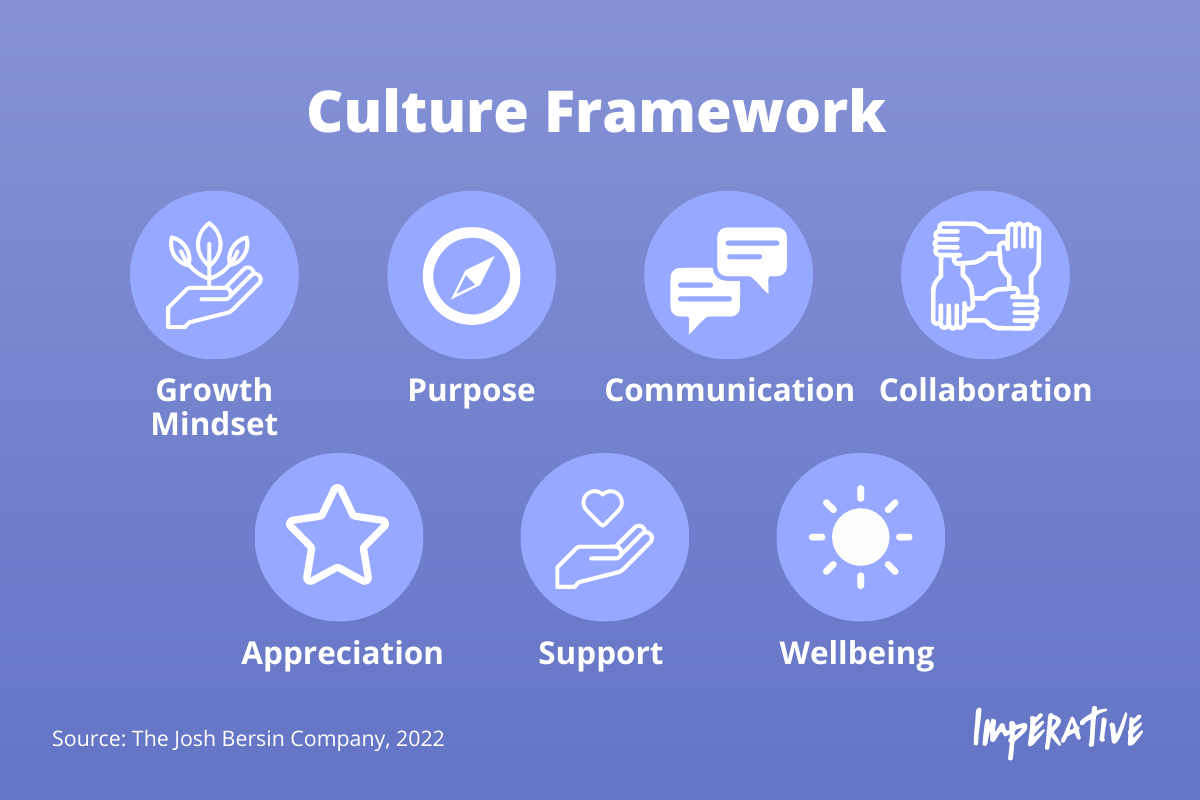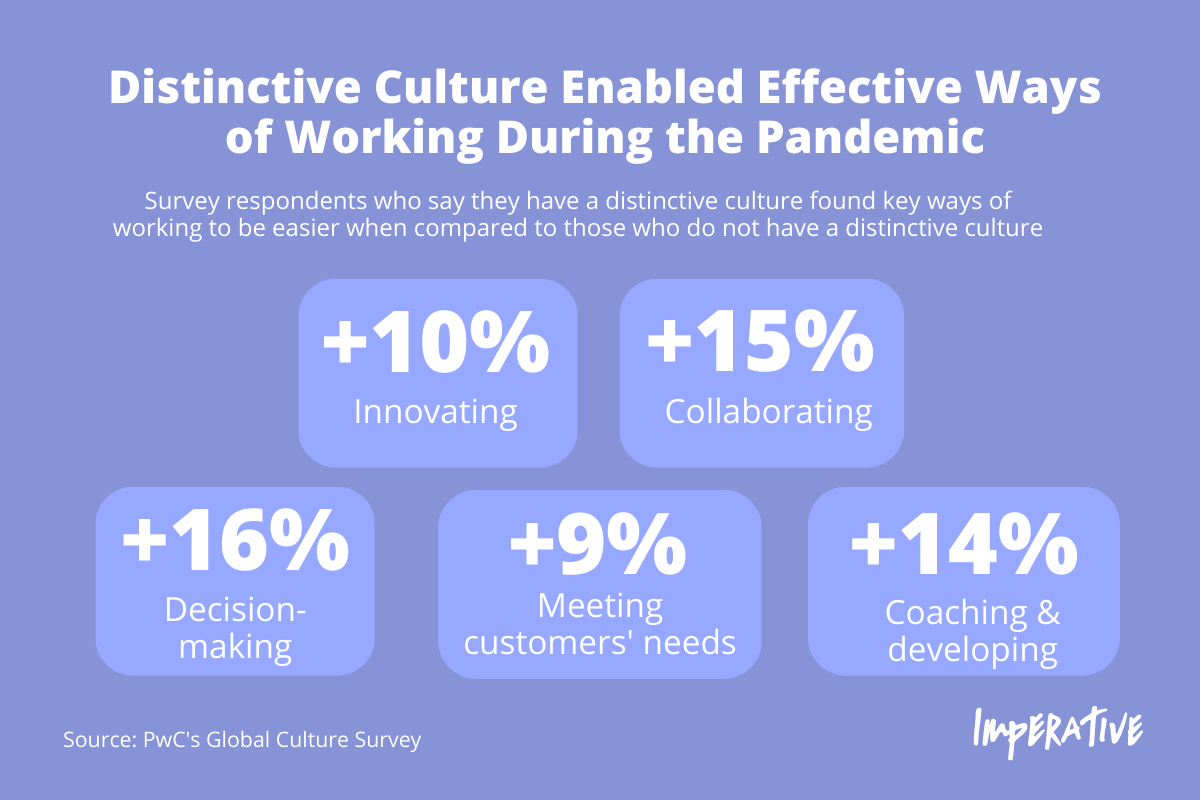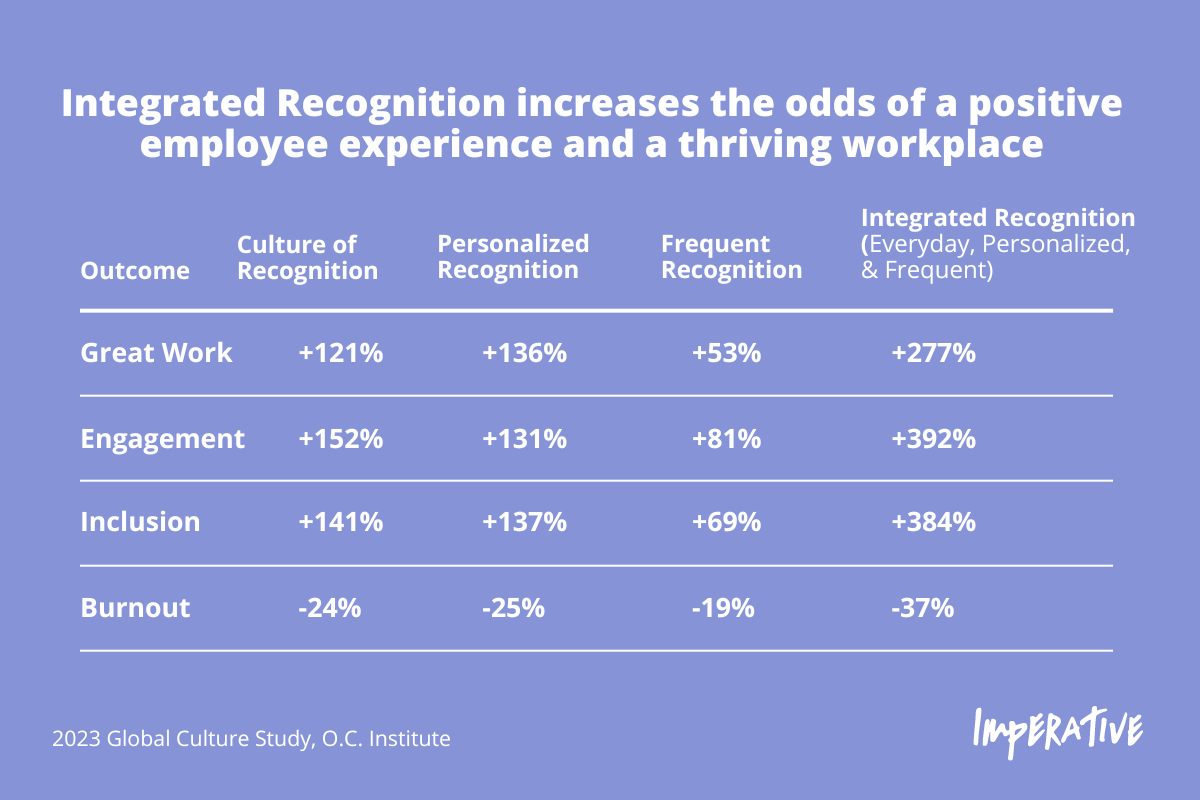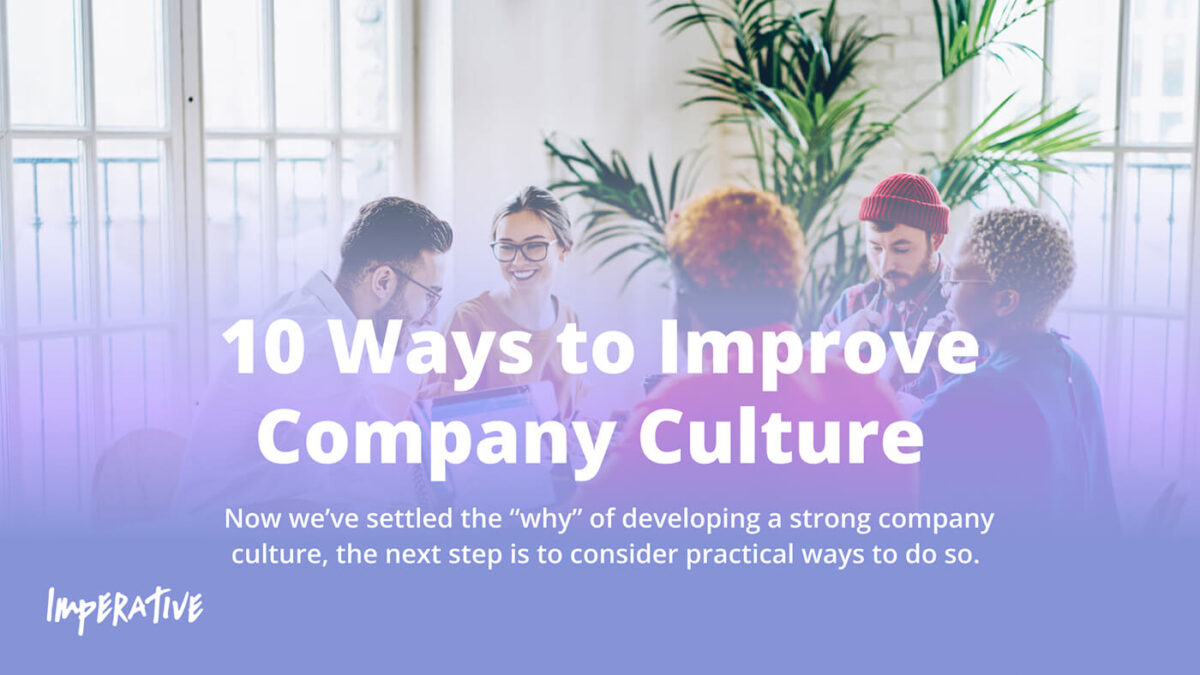Company Culture
10 Steps To Improve Company Culture at Work
What This Article Covers:
How would you describe the DNA of your company or workplace culture? Are your teams filled with positive, engaged employees striving to make a difference—not just in their individual careers but in tandem with your company mission? Or is the general vibe more lackluster—it’s hard to put your finger on why things aren’t working, but you’re not achieving the impact your business or your employees deserve?
Our guide provides practical steps to improve your company culture, regardless of its current condition. By downloading our template, you’ll have an actionable checklist to strengthen, improve or completely redefine your culture. Keep reading to make your organization a place employees are proud to be part of, actively engaged in, and your customers are pleased to support.
What is company or workplace culture?
Culture can be hard to define; it’s as unique as a thumbprint and incorporates an organization’s blend of company values, working practices, and treatment of employees. The Katzenbach Center defines culture as “the self-sustaining pattern of behaviors that determine how things are done,” which Christina Dove, Culture Leader at Mercer, agrees with. Speaking on the “Energizing the Employee Experience” podcast, she explains:
“People talk a lot about culture and mean different things. It could be a wellbeing culture, a DEI culture, or a flexible working culture. For me, it’s “how we do things around here.” It’s how you turn up every single day to work, how you do your work, how you deliver to clients, how you interact with each other, how innovative you are, how risk-taking you are, whether your organization trusts you, empowers you, it’s all of those things. It’s really important to define what your culture is and what you want it to be. That provides a north star or a compass to everybody to galvanize around.”
Digging deeper into what it looks like, HR thought leader Josh Bersin outlines the critical elements of company and workplace culture that influence business success, performance, and failure:
- Growth mindset: Emphasizing the belief in continuous learning and development to foster adaptability and improvement among employees
- Purpose: Aligning employees with a clear sense of the company’s mission and values, inspiring a shared vision and commitment
- Communication: Cultivating open, transparent, and effective channels for information sharing and feedback across the organization.
- Support: Providing resources, mentorship, and assistance empowers employees to achieve their goals and overcome challenges.
- Collaboration: Encouraging teamwork, cooperation, and cross-functional interaction to drive innovation and collective problem-solving.
- Appreciation: Recognizing and celebrating employee contributions and achievements to boost morale and motivation.
- Wellbeing: Prioritizing employee health and work-life balance, promoting physical, mental, and emotional wellbeing in the workplace

What are the different types of cultural change in a company?
Company culture is a broad concept, so it follows that there are multiple ways to change it within your organization. Here are a sample of areas you might focus on in your business:
Optimizing your hybrid or remote culture
Forbes reports that 12.7% of US full-time employees work from home, while 28.2% work a hybrid model. Although this flexibility offers countless work-life balance advantages, it does present challenges for companies. Buffer’s State of Remote Work 2023 report highlights the biggest struggles that 3,000 US employees face when working remotely:
- 14% struggle with working across time zones
- 8% experience difficulties with collaboration and communication
- 11% lack motivation
- 9% find themselves working more
- 9% struggle to focus
- 15% feel lonely
Companies can respond by offering digital collaboration tools, virtual team-building activities, remote working policies, and other initiatives that bridge the gap between working remotely or in a hybrid model.
Embracing new work methodologies
Besides the constant need to embrace new digital technologies such as AI or automation, companies may also adopt new mentalities around the way they work to drive progress:
Example 1: Traditional organizations may recognize they need to switch to a more innovative workplace culture, where they give their employees the space to be creative and explore new concepts or products.
Example 2: Business leaders may have identified organizational silos where departments or individuals work independently from one another. Cultural change will center on building a cross-collaborative team environment where knowledge flows freely and everyone feels connected.
Switching to agile work practices
Agile work practices are increasingly popular, especially in the tech industry, which leans on scrum meetings, iterative work cycles, and a value-driven approach to projects that result in high customer satisfaction.
This kind of cultural shift requires considerable organizational commitment and change management efforts. Expect to redefine roles, reestablish norms, and transform processes for a more adaptable organization.
Adopting a more inclusive culture
Inclusivity in the workplace goes beyond mere tolerance to fostering an environment of belonging for all employees, regardless of race, ethnicity, gender, age, religion, disability, or sexual orientation.
Cultural change is based on creating a comprehensive DEI strategy to support diverse people in the workplace. This may include:
- Setting up employee resource groups (ERGs)
- Adopting inclusive recruitment sourcing policies
- Implementing strict anti-discrimination initiatives
Strengthening the fabric of your existing culture
Cultural transformations are often about taking existing components and deciding whether to improve, strengthen or replace them. Evaluate and reinforce your existing culture by:
- Reviewing your core values and how they are expressed throughout the organization
- Developing initiatives to reward employees for displaying desired behaviors
- Enhancing opportunities for feedback and engagement
- Devising a plan to track you’re moving toward your cultural goals
What are the business implications when corporate culture is suffering?
Culture in the workplace is worth investing in. Miss this step, and your business could suffer the following:
1. Employee disengagement and productivity
Low engagement costs the global economy $8.8 trillion, with Gallup’s research highlighting that having a job you hate is worse than being unemployed.
Leaders can turn the tide on employee disengagement by making simple changes to organizational culture so employees recommit to their roles and increase their productivity. Why? 6 in 10 employees who have quietly quit may re-engage with the right manager behind them. For example, research shows that training managers to be effective coaches increases team engagement by 8 to 18%.
2. Difficulties working in times of crisis
A robust organizational culture can weather the storm when a crisis hits by providing a sense of security and alignment throughout the company. PwC’s Global Culture Survey backs this up, revealing the significant gap between companies with or without a distinctive culture and how the COVID-19 pandemic impacted each type. Companies without a strong culture were:
- 16% less likely to excel at decision-making
- 15% worse at collaborating
- 10% less innovative
- 14% worse at coaching and developing
- 9% less effective at meeting customers’ needs

3. Legal and compliance risks
Poor or toxic workplace culture may result in discrimination, harassment, and hostile work environments, leading to legal claims and liabilities. Whistleblowing efforts may be ineffective if employees fear retaliation for reporting misconduct.
Any non-compliance with employment laws, health and safety violations, and breaches of contracts can expose organizations to significant financial penalties and further damage company culture.
4. Reputational damage
Warren Buffet famously said, “It takes 20 years to build a reputation and five minutes to ruin it. If you think about that, you’ll do things differently.”
A toxic culture can cause reputation damage by harming customers’ perception of your brand and impacting your ability to attract top talent. Research shows that 69% of candidates would reject a job offer from a company with a poor reputation, even if they were unemployed, strengthening the need to build a thriving culture that attracts quality applicants.
5. Team conflict
A negative culture can lead to higher levels of conflict and tension among employees, hampering collaboration and communication.
- Example 1: Team meetings regularly end in disagreements and bickering, with no one willing to compromise. The team leader is unable to take control and persuade everyone to listen to each other’s views, which ultimately stifles innovation.
- Example 2: Individual employees would rather work independently than cooperate on projects, resulting in delayed deliveries and sub-par results. The team lacks bonding activities or rewards for successful outputs so employees don’t feel motivated to work together.
10 ways to improve company, workplace, and remote work culture
Now we’ve settled the “why” of developing a strong corporate culture, the next step is to consider practical ways to do so. Let’s look at how to improve work culture:
1. Define your company’s core values
Your company values are the foundation for every aspect of your organization, guiding decision-making and influencing your workforce’s behavior and performance. Your values must reflect your vision and aspirations and be communicated clearly and consistently, incorporated into daily operations, and reflected in company policies and strategies.
Unless you’re a startup, you probably already have existing brand values to build on. Consider how these fit into your company’s current culture and how they could be updated to reflect its future aspirations. Ask the following questions:
- Do our employees know our values, and are they meaningful to them?
- Are our values reflected in our daily operations and decisions?
- How are our values communicated to new employees during onboarding?
- Do our values encourage diversity, inclusivity, and respect in the workplace?
- Are we ready to uphold these values even when it’s challenging?
2. Lead by example
Leaders should demonstrate their commitment to the company’s values by leading with integrity and consistency. Having visible role models at the top of the organization will inspire employees to follow suit, creating a strong culture built on trust and respect. This starts from the beginning of the recruitment process—ensure every new hire clearly understands the company’s values and how their role supports them. Christina Dove explains,
“It has to be throughout the whole of the organization. Leaders have to walk and talk, communicate, and be authentic leaders of that culture. Obviously, it has to be built from the top down and bottom up; everyone has to be involved in building that culture, but leaders have to be behind it.”
3. Embrace communication
Leaders must first gather and then visibly act on the feedback they receive. We know from Salesforce data that employees are 4.6x more likely to perform better when they feel their voice is heard. Try the following strategies to embed two-way communication loops in your company:
- Hold regular town hall meetings and praise employees who are embracing your company values
- Make space for workers to speak up about their opinions and share ideas in team meetings
- Promote cross-functional communication by setting up hack days or team-building activities
- Set up 1:1 conversations between employees to keep each other accountable for living the company’s values or discuss any cultural changes
At Imperative, we create scale connections, resulting in tighter communication and organizational relationships.
4. Set up reward and recognition systems
Praise and shoutouts reward and recognize employees who exhibit core company values daily. Deliver this praise in person or using specialist reward and recognition software that connects with your existing tech stack. Recognizing team accomplishments will help build camaraderie and foster stronger collaborative relationships.
Along with the powerful results below, O.C Tanner’s 2023 Global Culture Study also reveals that integrated recognition (which is frequent, personalized, and baked into your daily culture) increases the odds of a positive employee experience and a thriving workplace culture by 391% and 646%, respectively.

5. Accelerate diversity, equity, inclusion, and belonging initiatives
Set DEIB goals to create a workplace where all employees are welcome and feel respected. These might include:
- Improving company representation by X% this year
- Introducing new policies that promote equity and reduce bias
- Creating a safe environment for all employees to express their ideas freely, without fear of reprisal or discrimination
- Providing accessible resources and guidance to support DEIB initiatives
- Investing in DEIB initiatives to create a sense of belonging and purpose for every employee
6. Build an environment of psychological safety
Psychological safety happens when employees feel comfortable sharing their ideas, asking questions, and raising concerns knowing that they won’t be ridiculed or punished. This goal requires consistent effort from leadership and team members alike by committing to the following strategies:
- Regularly soliciting feedback
- Encouraging open dialogue
- Advocating for employee well-being
- Modeling vulnerability and openness
7. Commit to inclusive team building
8 out of 10 employees report they want to work for an organization where they feel connected to the people. To achieve this, companies don’t need to invest in expensive corporate team building as part of a cringey away day. Instead, organizations can introduce simple, regular activities that encourage social connections, such as:
- Using icebreakers at the beginning of every meeting to foster relationships
- Having dedicated ‘social time’ every week for team members to chat and get to know each other on a personal level
- Creating Slack channels structured around shared interests or hobbies – such as sports, reading, music, etc.
- Offering online courses or training sessions on topics related to team building and cultural inclusivity
With Imperative, you can set up dynamic guided conversations focused on shared experiences and challenges that build rapport and accelerate bonding between team members.
8. Provide a better work-life balance
Employee burnout is rising globally, with 43% of US desk workers feeling burned out and executives reporting a 20% drop in work-life balance over the past year. A Future Forum Pulse report also cites flexible remote work policies as the main factor in improving company culture.
Besides flexible working, employers can introduce some of the following measures to provide balance and prevent burnout:
- Setting clear communication boundaries, such as not sending emails after 6 pm or on the weekends so colleagues don’t feel pressured to respond
- Avoiding back-to-back meetings to prevent Zoom burnout
- Reviewing company benefits to enhance employees’ personal and professional lives
- Reminding employees to take vacation days and providing support for volunteering, yoga classes, or other activities that promote mental health
- Establishing weekly check-ins with team members to ensure they’re feeling supported and not overworked
9. Establish mentorship and coaching opportunities
The LinkedIn Workplace Learning Report highlights that mentorship and coaching programs top the program priority list for L&D leaders. Mentorship transforms workplace culture by fostering employee development, improving communication, and creating a more supportive and inclusive work environment. To get started, employers can consider the following:
- Establishing formal or informal mentorship initiatives with clear guidelines and expectations
- Identifying mentors who will be well-positioned to foster talent development and positive relationships
- Offering training to enable mentors and mentees to gain the necessary skills for successful coaching
- Installing a feedback loop for mentors and mentees to ensure they’re achieving their desired outcomes
Imperative is the perfect platform to host your mentoring relationships, allowing mentor and mentee to engage in powerful conversations that facilitate growth and continuous development.
10. Measure company culture
Don’t make the mistake of setting the wheels of cultural transformation off, then waiting to see what happens. Your company will only know if you’ve achieved real change by tracking the success of your culture change initiatives. Do this by:
- Benchmarking your existing organizational culture before you begin which might involve taking employee surveys, and monitoring metrics such as employee turnover and absenteeism
- Creating an action plan for the future with measurable goals and timelines for each initiative
- Measuring progress as you implement initiatives using 1:1 meetings, exit interviews, engagement with team-building activities, or employee sentiment surveys. Imperative makes it easy to extract and analyze actionable employee data to assess against your goals
- Celebrating successes through case studies or team shoutouts to encourage further participation in culture change initiatives
- Sustain and iterate using Imperative’s platform to continue boosting employee engagement and maintain a positive work culture
Overhaul company culture with Imperative
Positive company and workplace culture is not optional but an essential element of a thriving organization. Strategic changes have a profound impact on a company’s culture and overall success. Through these shifts, companies foster a sense of belonging and purpose among employees and drive higher productivity, innovation, and business growth.
As we forge ahead, it becomes increasingly clear that a culture of engagement, trust, and continuous learning is key to organizational resilience and success. That’s where Imperative allows your business to thrive. As a holistic partner, you can customize Imperative to suit your specific engagement initiatives, and receive detailed insights to unlock the potential of your workforce. Best of all, our platform integrates the rest of your HR tech stack, allowing you to sync meaningful data between performance and learning management systems and really keep tabs on what’s going on.
Remember: Changing company culture may be complex and lengthy, but the rewards it produces are invaluable and long-lasting. Get started on your cultural transformation by downloading our actionable guide on 10 Practical Ways to Improve Company Culture.
Get the Company Culture Guide.

FAQs
We’ve come to the end of our guide on how to improve culture at work. Here are some frequently asked questions on the topics of company culture, positive workplace culture, cultural transformation, creating a positive company culture and more:
